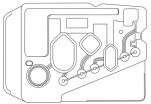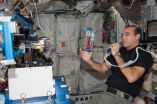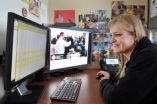HOUSTON, TX, April 21, 2014 (Press-News.org) A new medical-testing device is being prepped to enter the battle against infectious disease. This instrument could improve diagnosis of certain diseases in remote areas, thanks in part to knowledge gained from a series of investigations aboard the International Space Station on the behavior of liquids. The device uses the space-tested concept of capillary flow to diagnose infectious diseases such as HIV/AIDS and tuberculosis.
David Kelso, Ph.D., a researcher at Northwestern University in Evanston, Ill., had been working for several years to develop a simple, inexpensive device that could be used in resource-limited settings to test for infectious diseases. When designs didn't work as expected in the lab, Kelso brought in Portland State University researcher Mark Weislogel, Ph.D., who is the principal investigator for the Capillary Flow Experiment (CFE) on the space station.
"He came by the lab, we ran two or three experiments for him, and he explained to us that the problem had to do with capillary flow," Kelso says. "Our mindset was that gravity would pull fluids through the device, but his mindset, due to his work in microgravity, was to use capillary action. His experience and work in zero-G was invaluable; he could look at something and not be constrained to just seeing the effects of gravity but other effects that we were blind to."
Cell samples in the form of blood or other bodily fluids are put into the device, where an enzyme fluid bursts the cells to release DNA or RNA. Another solution washes away the enzyme and the cellular debris, leaving behind the DNA or RNA, which is captured on a bead and used to identify infectious viruses. "You only need fewer than a dozen particles, and you can detect the presence of the virus," Kelso explains. "It's a phenomenal analytical technique, but it involves four different fluids that have to be moved around."
That's where capillary forces come into play. The interaction between a liquid and a solid that draws a fluid up a narrow tube, capillary forces continue to operate in microgravity, and the low-gravity environment on the space station enabled researchers to conduct investigations into the special dynamics of this fluid behavior. The CFE series clarified the properties of the boundary between a liquid and the solid surface of its container and the flow of liquids under certain conditions. This knowledge will prove useful in designing fluid-bearing containers such as propellant tanks and water storage and management systems. It also will aid in creating instruments that use bio-fluids - including the medical testing device the Northwestern lab is developing.
"The capillary flow knowledge is just amazing," Kelso says. "It's a way to move fluids without putting any energy into the device. We were using motors and batteries and all these things that consume power to make the device work. Doing it with capillary action uses much less energy." That makes it possible to diagnose infectious diseases in places where there is no power or where power is unreliable. It also reduces the time between sample collection and diagnosis and, therefore, initiation of treatment.
"This cartridge and the way fluid moves in it are an important part of measuring viral load level," says Kara Palamountain, president of the Northwestern Global Health Foundation. "Capillary flow helped us understand more about our assumptions and explains the movement we see in the cartridge, which we wouldn't have seen otherwise.
"There are shortages of health care workers of all cadres, from lab technician to community health care workers, so the less constraint we put on the end user the better," she adds. "This wouldn't necessarily require a lab technician or even a lab. It frees up a health care worker." The ability to easily and inexpensively test viral load also makes it possible to monitor the effectiveness of anti-viral medications in the field.
The researchers plan to conduct field studies of the testing device in Africa by the end of this year. If all goes as expected, space research will have become a new weapon in the battle against infectious diseases in remote corners of Earth.
Melissa Gaskill
International Space Station Program Office
NASA Johnson Space Center
Space-tested Fluid Flow Concept Advances Infectious Disease Diagnoses
A new medical-testing device is being prepped to improve diagnosis of certain diseases in remote areas, thanks in part to knowledge gained from a series of investigations aboard the International Space Station on the behavior of liquids.
2014-04-21
ELSE PRESS RELEASES FROM THIS DATE:
EMPORIO SAN FIRENZE: Fine Italian Wrought Iron Furnishing Collections - Now Available Through Anne Thull Fine Art Designs
2014-04-21
The fine Italian wrought iron Furnishing Collections of CIANI - EMPORIO SAN FIRENZE www.EmporioSanFirenze.com have continually satisfied the need for art and commercial production, typical of the evolution of artisan workmanship from the Florentine Renaissance to today. Each product begins with hand drawings and is then fabricated by carefully pairing various materials of art glass, bronze, pewter, marble or fine fabrics with specialty finishes of gold, rust, silver or painted color combinations. Interior and exterior collections from antique reproductions to modern design ...
UCSF study finds codeine often prescribed to children, despite available alternatives
2014-04-21
Despite its potentially harmful effects in children, codeine continues to be prescribed in U.S. emergency rooms, according to new research from UCSF Benioff Children's Hospital San Francisco.
As reported in the May issue of Pediatrics, solutions include changing provider prescription behaviors to promote the use of better alternatives to codeine, such as ibuprofen or hydrocodone.
"Despite strong evidence against the use of codeine in children, the drug continues to be prescribed to large numbers of them each year," said Sunitha Kaiser, MD, UCSF assistant clinical professor ...
Airport security officers at TSA gaining insight from Sandia human behavior studies
2014-04-21
LIVERMORE, Calif.— A recent Sandia National Laboratories study offers insight into how a federal transportation security officer's thought process can influence decisions made during airport baggage screening, findings that are helping the Transportation Security Administration (TSA) improve the performance of its security officers.
The TSA-funded project, led by Sandia researchers Ann Speed and Kiran Lakkaraju, focused on the impacts on threat detection when transportation security officers are asked to switch between the pre-check (indicated by TSA as TSA Pre✓) ...
Low tolerance for pain? The reason may be in your genes
2014-04-20
PHILADELPHIA – Researchers may have identified key genes linked to why some people have a higher tolerance for pain than others, according to a study released today that will be presented at the American Academy of Neurology's 66th Annual Meeting in Philadelphia, April 26 to May 3, 2014.
"Our study is quite significant because it provides an objective way to understand pain and why different individuals have different pain tolerance levels," said study author Tobore Onojjighofia, MD, MPH, with Proove Biosciences and a member of the American Academy of Neurology. "Identifying ...
'Chaperone' compounds offer new approach to Alzheimer's treatment
2014-04-20
NEW YORK, NY (April 20, 2014) — A team of researchers from Columbia University Medical Center (CUMC), Weill Cornell Medical College, and Brandeis University has devised a wholly new approach to the treatment of Alzheimer's disease involving the so-called retromer protein complex. Retromer plays a vital role in neurons, steering amyloid precursor protein (APP) away from a region of the cell where APP is cleaved, creating the potentially toxic byproduct amyloid-beta, which is thought to contribute to the development of Alzheimer's.
Using computer-based virtual screening, ...
Bulletproof nuclei? Stem cells exhibit unusual absorption property
2014-04-20
Stem cells – the body's master cells – demonstrate a bizarre property never before seen at a cellular level, according to a study published today from scientists at the University of Cambridge. The property – known as auxeticity – is one which may have application as wide-ranging as soundproofing, super-absorbent sponges and bulletproof vests.
Most materials when stretched will contract. For example, if one pulls on an elastic band, the elastic itself will get thinner. The opposite is also true: squeeze a material and it will expand – for example, if one squeezes a tennis ...
Computational method dramatically speeds up estimates of gene expression
2014-04-20
PITTSBURGH—With gene expression analysis growing in importance for both basic researchers and medical practitioners, researchers at Carnegie Mellon University and the University of Maryland have developed a new computational method that dramatically speeds up estimates of gene activity from RNA sequencing (RNA-seq) data.
With the new method, dubbed Sailfish after the famously speedy fish, estimates of gene expression that previously took many hours can be completed in a few minutes, with accuracy that equals or exceeds previous methods. The researchers' report on their ...
Cancer stem cells linked to drug resistance
2014-04-20
Most drugs used to treat lung, breast and pancreatic cancers also promote drug-resistance and ultimately spur tumor growth. Researchers at the University of California, San Diego School of Medicine have discovered a molecule, or biomarker, called CD61 on the surface of drug-resistant tumors that appears responsible for inducing tumor metastasis by enhancing the stem cell-like properties of cancer cells.
The findings, published in the April 20, 2014 online issue of Nature Cell Biology, may point to new therapeutic opportunities for reversing drug resistance in a range ...
Study of gut microbes, antibiotics: Clues to improving immunity in premature infants
2014-04-20
Mothers give a newborn baby a gift of germs—germs that help to kick-start the infant's immune system. But antibiotics, used to fend off infection, may paradoxically interrupt a newborn's own immune responses, leaving already-vulnerable premature babies more susceptible to dangerous pathogens.
A new animal study by neonatology researchers at The Children's Hospital of Philadelphia (CHOP) sheds light on immunology in newborns by revealing how gut microbes play a crucial role in fostering the rapid production of infection-fighting white blood cells, called granulocytes.
"At ...
Dana-Farber researchers uncover link between Down syndrome and leukemia
2014-04-20
BOSTON –Although doctors have long known that people with Down syndrome have a heightened risk of developing acute lymphoblastic leukemia (ALL) during childhood, they haven't been able to explain why. Now, a team of Dana-Farber Cancer Institute investigators has uncovered a connection between the two conditions.
In a study posted online today by the journal Nature Genetics, the researchers track the genetic chain of events that links a chromosomal abnormality in Down syndrome to the cellular havoc that occurs in ALL. Their findings are relevant not only to people with ...
LAST 30 PRESS RELEASES:
New study reveals 33% gap in transplant access for UK’s poorest children
Dysregulated epigenetic memory in early embryos offers new clues to the inheritance of polycystic ovary syndrome (PCOS)
IVF and IUI pregnancy rates remain stable across Europe, despite an increasing uptake of single embryo transfer
It takes a village: Chimpanzee babies do better when their moms have social connections
From lab to market: how renewable polymers could transform medicine
Striking increase in obesity observed among youth between 2011 and 2023
No evidence that medications trigger microscopic colitis in older adults
NYUAD researchers find link between brain growth and mental health disorders
Aging-related inflammation is not universal across human populations, new study finds
University of Oregon to create national children’s mental health center with $11 million federal grant
Rare achievement: UTA undergrad publishes research
Fact or fiction? The ADHD info dilemma
Genetic ancestry linked to risk of severe dengue
Genomes reveal the Norwegian lemming as one of the youngest mammal species
Early birds get the burn: Monash study finds early bedtimes associated with more physical activity
Groundbreaking analysis provides day-by-day insight into prehistoric plankton’s capacity for change
Southern Ocean saltier, hotter and losing ice fast as decades-long trend unexpectedly reverses
Human fishing reshaped Caribbean reef food webs, 7000-year old exposed fossilized reefs reveal
Killer whales, kind gestures: Orcas offer food to humans in the wild
Hurricane ecology research reveals critical vulnerabilities of coastal ecosystems
Montana State geologist’s Antarctic research focuses on accumulations of rare earth elements
Groundbreaking cancer therapy clinical trial with US Department of Energy’s accelerator-produced actinium-225 set to begin this summer
Tens of thousands of heart attacks and strokes could be avoided each year if cholesterol-lowering drugs were used according to guidelines
Leading cancer and metabolic disease expert Michael Karin joins Sanford Burnham Prebys
Low-intensity brain stimulation may restore neuron health in Alzheimer's disease
Four-day school week may not be best for students, review finds
Using music to explore the dynamics of emotions
How the brain supports social processing as people age
Túngara frog tadpoles that grew up in the city developed faster but ended up being smaller
Where there’s fire, there’s smoke
[Press-News.org] Space-tested Fluid Flow Concept Advances Infectious Disease DiagnosesA new medical-testing device is being prepped to improve diagnosis of certain diseases in remote areas, thanks in part to knowledge gained from a series of investigations aboard the International Space Station on the behavior of liquids.





